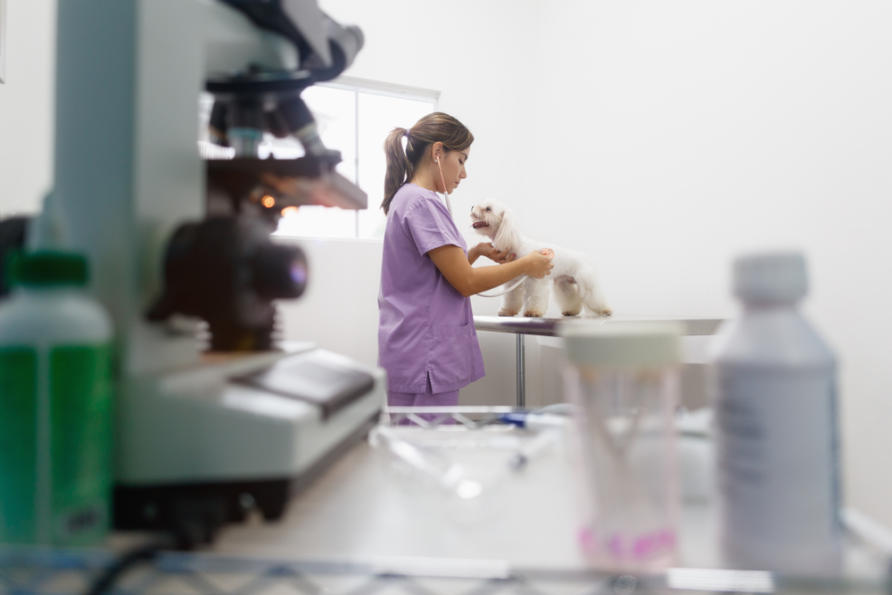Sometimes it’s the vet who is the first medical professional to see the signs of family violence
The signs of deliberate injury to a pet are not hard to spot for an experienced veterinarian.
The severity of a dog’s injuries may contradict an owner’s description of it ‘falling off a couch’. X-rays might show old fractures that haven’t been properly treated. Sometimes injuries are sexual in nature.
Dr Elise Boller, a clinical veterinarian at the University of Melbourne’s U-Vet Hospital and Senior Lecturer in Emergency and Critical Care at the Melbourne Veterinary School, says her first steps in these cases are to stabilise the animal, thoroughly document her findings, including safe communications with the owner, and importantly, consider its context.
“You have to be aware that it’s sometimes a suspicion rather than something that’s been disclosed, but if there is non-accidental injury, there could be a serious situation at home that involves the safety of people, including children,” she says.
“In these situations, it’s important to look after the safety of the animal, the client and yourself. This can mean taking a person into a more private area and asking questions like, ‘Is there anything that worries you about taking your pet home?’ or providing an indirect method of query like a questionnaire.”
 It may not be the perpetrator who brings an injured animal to a vet. Just as some partners will use money and social relationships to control other family members, threatening, harming or even killing a companion animal is another known tactic.
It may not be the perpetrator who brings an injured animal to a vet. Just as some partners will use money and social relationships to control other family members, threatening, harming or even killing a companion animal is another known tactic.
Karnali province govt introduces Animal Welfare Standards-2080

In family violence situations this is all too common. In one Victorian study, 52.9 per cent of women who experienced domestic violence reported a violent partner had hurt or killed one of their pets. In a US study 71 per cent of women seeking refuge from abusive relationships reported their partner had threatened, harmed or killed at least one of their pets.
“It is widely accepted that pet abuse may be an indicator of an increased risk of family violence, with perpetrators harming or killing a pet to control an intimate partner physically, psychologically or emotionally,” says Dr Boller.
“This requires an interdisciplinary response which takes into account the importance of the human-animal bond.”
Bringing vets, family violence practitioners and policymakers together is an important step towards streamlining responses that safeguard the victims of family violence with pets.
The upcoming Lucy’s Project Conference, Domestic Violence and Animal Abuse – Strategic and Practical Perspectives, which will be co-hosted by the University of Melbourne, will help build these connections.
“I do a lot of research on family violence and risk assessment,” says Dr Kristin Diemer, a sociologist at the University who is involved in conference planning.
“One of the risk questions a family violence practitioner will ask women is whether there have been threats to animals. Further, many women won’t leave their situation if they are concerned for the safety of their animals.
“At the moment it’s a fragmented system. Individual organisations have to find their own links to animal support. We’d like to be able to find a way to streamline strategic connections rather than everybody having to scramble to cobble something together.”
 A 2012 New Zealand study found 60 per cent of participants had delayed leaving a dangerous situation because they were concerned about a pet. It can be difficult to find refuges for victims of family violence that take pets, particularly outside metropolitan areas.
A 2012 New Zealand study found 60 per cent of participants had delayed leaving a dangerous situation because they were concerned about a pet. It can be difficult to find refuges for victims of family violence that take pets, particularly outside metropolitan areas.
Another important issue is preparing vets for how to respond when they suspect a family violence situation, or for when an owner wishes to discuss one.
The University of Melbourne has been teaching vet students about recognising non-accidental injury in pets and communicating with owners on this topic since 2015, after being approached with the suggestion to do so by EDVOS, the Eastern Domestic Violence Outreach Service.
Dr Boller says the seminar, which was designed in collaboration with other Melbourne Veterinary School lecturers and family violence experts from the School of Health Sciences, is very well-received.
“This topic can be very confronting, but our research shows students are more confident in identifying non-accidental injury and were more likely to agree that pet abuse and family violence were linked after this seminar,” she says.
“They also had a better understanding of their legal responsibilities and a higher degree of confidence in discussing the issue with clients.”
The next step, says Dr Boller, is to spread the word to practising vets, who may not have had such training.
Anna Ludvik, a lawyer from Lismore in rural New South Wales, founded Lucy’s Project to raise awareness of “the link” between family violence and the abuse of pets.
Lucy’s Project is named to honour the stillbirth of Ms Ludvik’s daughter Lucy in 2013. This year will mark the third conference.
She says there are an enormous range of issues to consider for families seeking to escape violence with pets.
“It becomes quite a complex field that we bring together, so we’re trying to develop a unified response. We fail to save human domestic violence victims’ lives when we fail to address the needs of the whole family, including its companion animals.”







































